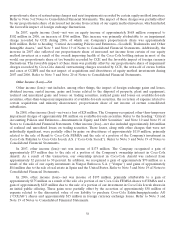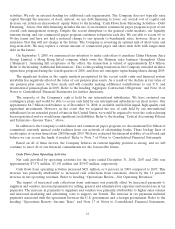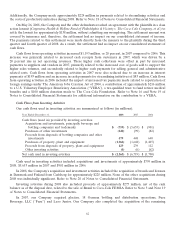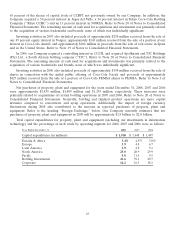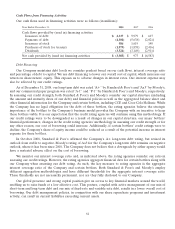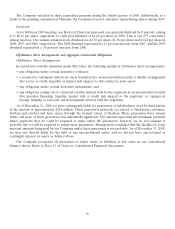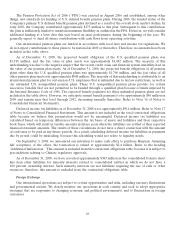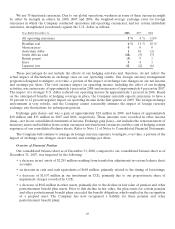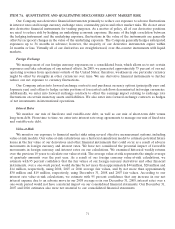Coca Cola 2008 Annual Report Download - page 63
Download and view the complete annual report
Please find page 63 of the 2008 Coca Cola annual report below. You can navigate through the pages in the report by either clicking on the pages listed below, or by using the keyword search tool below to find specific information within the annual report.activities. We rely on external funding for additional cash requirements. The Company does not typically raise
capital through the issuance of stock, instead, we use debt financing to lower our overall cost of capital and
increase our return on shareowners’ equity. Refer to the heading ‘‘Cash Flows from Financing Activities—Debt
Financing,’’ below. Our debt financing includes the use of an extensive commercial paper program as part of our
overall cash management strategy. Despite the recent disruption to the general credit markets, our liquidity
remains strong, and our commercial paper program continues to function each day. We are able to access 60- to
90-day terms and have not had a material change to our spreads to benchmark rates; however, there is no
assurance that this will not change in the future. The Company is reviewing its optimal mix of short-term and
long-term debt. We may replace a certain amount of commercial paper and short-term debt with longer-term
debt in the future.
On September 3, 2008, we announced our intention to make cash offers to purchase China Huiyuan Juice
Group Limited, a Hong Kong listed company which owns the Huiyuan juice business throughout China
(‘‘Huiyuan’’). Assuming full acceptance of the offers, the transaction is valued at approximately $2.4 billion.
Refer to the heading ‘‘Additional Information.’’ Due to this pending transaction, the Company curtailed its share
repurchase program during the fourth quarter of 2008, and does not anticipate repurchasing shares during 2009.
The significant decline in the equity markets precipitated by the recent credit crisis and financial system
instability has negatively affected the value of our pension plan assets. As a result of the decline in fair value of
our pension plan assets, we have made and will consider making additional contributions to our U.S. and
international pension plans in 2009. Refer to the heading ‘‘Aggregate Contractual Obligations’’ and Note 16 of
Notes to Consolidated Financial Statements for further discussion.
The majority of the Company’s cash is held by our international subsidiaries. We have reviewed our
contingency plans and would be able to access cash held by our international subsidiaries on short notice. Our
approximate $4.7 billion cash balance as of December 31, 2008, is available and held in liquid, high-quality cash
equivalent investments. However, in the event that we required the use of cash held by our international
subsidiaries for an extended period of time in the United States, we would be required to treat the cash as having
been repatriated and we would incur significant tax liabilities. Refer to the heading ‘‘Critical Accounting Policies
and Estimates—Income Taxes,’’ above.
In addition to the Company’s cash balances and commercial paper program, we also maintain $2.6 billion of
committed, currently unused credit facilities from our network of relationship banks. These backup lines of
credit expire at various times from 2009 through 2013. We have evaluated the financial stability of each bank and
believe we can access the funds, if needed. Refer to Note 7 of Notes to Consolidated Financial Statements.
Based on all of these factors, the Company believes its current liquidity position is strong, and we will
continue to meet all of our financial commitments for the foreseeable future.
Cash Flows from Operating Activities
Net cash provided by operating activities for the years ended December 31, 2008, 2007 and 2006 was
approximately $7,571 million, $7,150 million and $5,957 million, respectively.
Cash flows from operating activities increased $421 million, or 6 percent, in 2008 compared to 2007. This
increase was primarily attributable to increased cash collections from customers, driven by the 11 percent
increase in net operating revenues. Refer to heading ‘‘Operations Review—Net Operating Revenues.’’
The impact of increased cash collections from customers was partially offset by increased payments to
suppliers and vendors, increased payments for selling, general and administrative expenses and an increase in tax
payments. The increase in payments to suppliers and vendors was primarily attributable to higher sales volume
and increased marketing and advertising costs to support our brands. The increase in tax payments included
payments associated with the agreement between the U.S. government and a foreign government. Refer to the
heading ‘‘Operations Review—Income Taxes’’ and Note 17 of Notes to Consolidated Financial Statements.
61









